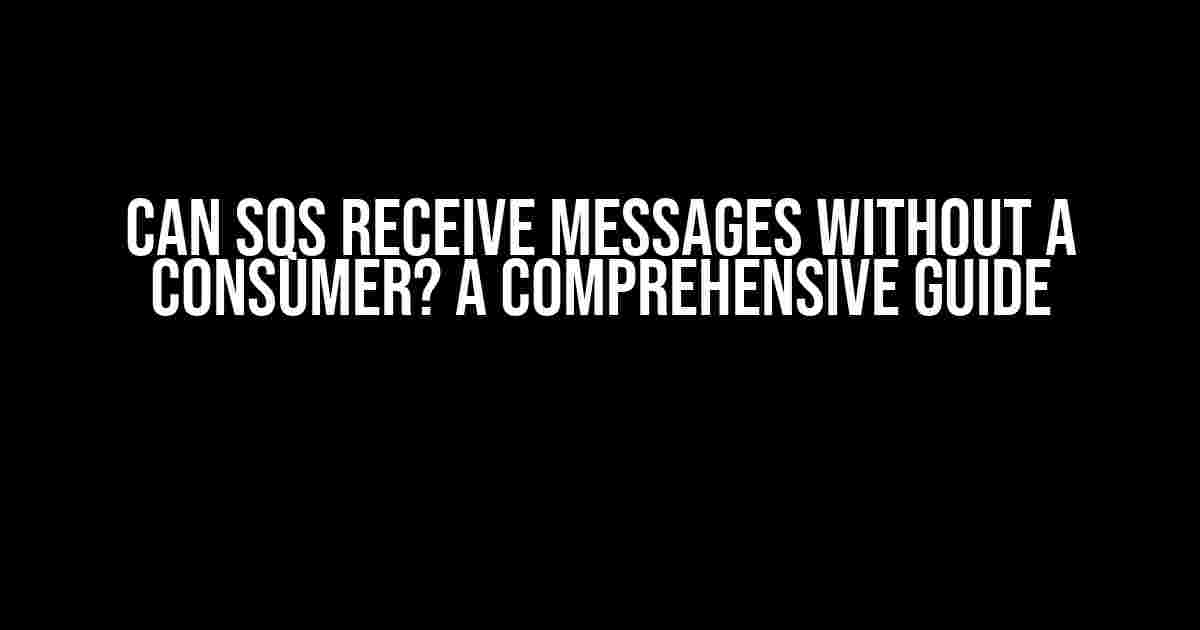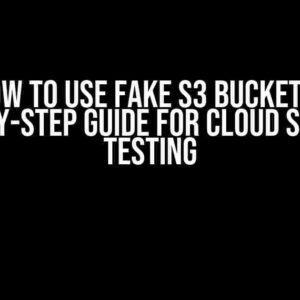Are you wondering if Amazon Simple Queue Service (SQS) can receive messages without a consumer? Well, you’ve come to the right place! In this article, we’ll dive into the intricacies of SQS and explore the possibilities of receiving messages without a consumer. But before we begin, let’s set the stage with a quick overview of SQS and its benefits.
What is Amazon SQS?
Amazon SQS is a fully managed message queuing service that enables decoupling of microservices, distributed systems, and serverless applications. It provides a highly scalable and reliable way to queue and process messages, letting you focus on building your application rather than worrying about message infrastructure.
Benefits of Using SQS
SQS offers a range of benefits, including:
- Decoupling**: SQS allows microservices to operate independently, reducing the risk of cascading failures and improving overall system resilience.
- Scalability**: SQS can handle high volumes of messages, making it an ideal choice for large-scale applications.
- Fault Tolerance**: SQS provides built-in retry mechanisms and dead-letter queues to handle message failures, ensuring that your application remains robust.
- Security**: SQS encryption and access controls ensure that messages are protected from unauthorized access.
Receiving Messages Without a Consumer?
Now that we’ve covered the basics of SQS, let’s address the million-dollar question: can SQS receive messages without a consumer? The short answer is yes, but with some caveats.
Producer-Only Mode
In producer-only mode, SQS can receive messages from a producer (e.g., an application or service) without a consumer. This mode is useful when you need to buffer messages temporarily or handle bursts of messages without immediate processing.
To enable producer-only mode, you can create an SQS queue without specifying a consumer. You can then use the SendMessage() API to send messages to the queue.
aws sqs send-message --queue-url https://sqs.us-east-1.amazonaws.com/123456789012/my-queue --message-body "Hello, world!')Using an SQS Lambda Trigger
An SQS Lambda trigger is a event source mapping that allows AWS Lambda to consume messages from an SQS queue. In this scenario, Lambda acts as the consumer, processing messages from the queue.
To set up an SQS Lambda trigger, follow these steps:
- Create an SQS queue and an AWS Lambda function.
- Configure the SQS queue as an event source for the Lambda function.
- Specify the Lambda function as the consumer for the SQS queue.
With an SQS Lambda trigger, you can process messages without a traditional consumer. The Lambda function will automatically consume messages from the queue, allowing you to focus on processing the messages rather than managing the queue.
aws lambda create-event-source-mapping --function-name my-lambda --queue-url https://sqs.us-east-1.amazonaws.com/123456789012/my-queueUsing an SQS Redrive Policy
An SQS redrive policy allows you to configure a dead-letter queue (DLQ) to receive messages that cannot be processed by the original consumer. In this scenario, the DLQ acts as a backup consumer, allowing you to handle message failures and retries.
To set up an SQS redrive policy, follow these steps:
- Create an SQS queue and a dead-letter queue (DLQ).
- Configure the DLQ as the redrive target for the original SQS queue.
- Specify the maximum receive count and retry interval for the redrive policy.
With an SQS redrive policy, you can ensure that messages are not lost in case of consumer failures, and the DLQ acts as a fallback consumer to receive and process the messages.
aws sqs set-queue-attributes --queue-url https://sqs.us-east-1.amazonaws.com/123456789012/my-queue --attributes file://redrive-policy.json| Scenario | Producer-Only Mode | SQS Lambda Trigger | SQS Redrive Policy |
|---|---|---|---|
| Consumer Required | No | Yes (Lambda function) | Yes (DLQ) |
| No processing | Lambda function processes messages | DLQ processes messages on retry | |
| Fallback Mechanism | No fallback | Lambda function retries on failure | DLQ receives messages on failure |
Conclusion
In conclusion, SQS can receive messages without a consumer, but the approach depends on your use case and requirements. Producer-only mode, SQS Lambda triggers, and SQS redrive policies offer different ways to handle messages without a traditional consumer. By understanding the capabilities and limitations of each approach, you can design a robust and scalable messaging system that meets your needs.
Remember to consider factors like message processing, fallback mechanisms, and consumer requirements when choosing the best approach for your application.
FAQs
Q: Can SQS receive messages without a consumer?
A: Yes, SQS can receive messages without a consumer using producer-only mode, SQS Lambda triggers, or SQS redrive policies.
Q: What is producer-only mode?
A: Producer-only mode allows SQS to receive messages from a producer without a consumer, useful for temporary message buffering or handling bursts of messages.
Q: How does an SQS Lambda trigger work?
A: An SQS Lambda trigger allows AWS Lambda to consume messages from an SQS queue, processing messages without a traditional consumer.
Q: What is an SQS redrive policy?
A: An SQS redrive policy configures a dead-letter queue (DLQ) to receive messages that cannot be processed by the original consumer, acting as a fallback consumer.
Further Reading
For more information on SQS and its features, check out the following resources:
- Amazon SQS API Reference: SendMessage
- AWS Lambda: Working with Amazon SQS
- Amazon SQS API Reference: SetQueueAttributes
I hope this comprehensive guide has helped you understand the possibilities and limitations of receiving messages without a consumer in SQS. Happy building!
Frequently Asked Question
Get the scoop on SQS and message reception without a consumer!
Can SQS receive messages without a consumer?
Yes, SQS can receive messages even if there is no consumer available to process them. SQS acts as a decoupling mechanism between producers and consumers, allowing messages to be stored in the queue until a consumer is available to process them.
How long do messages stay in SQS if there’s no consumer?
Messages in SQS will remain in the queue until they are consumed, until the message retention period is reached, or until the queue is purged. The message retention period can be set between 1 minute and 14 days, depending on your needs.
What happens if multiple consumers are competing for messages in SQS?
When multiple consumers compete for messages in SQS, Amazon SQS uses a distributed locking mechanism to ensure that each message is processed only once. This ensures that even if multiple consumers are competing for the same message, only one consumer will receive and process it.
Can I use SQS to buffer messages during high-traffic periods?
Yes, SQS is an excellent way to buffer messages during high-traffic periods. By using SQS as a buffer, you can decouple your producers and consumers, allowing your system to handle sudden spikes in traffic without message loss or service disruptions.
Are there any limits on the number of messages that can be stored in SQS?
Yes, there are limits on the number of messages that can be stored in SQS. The maximum number of messages that can be stored in an SQS standard queue is 120,000. If you need to store more messages, consider using an SQS FIFO queue, which has a much higher message storage capacity.



